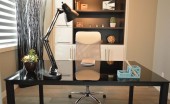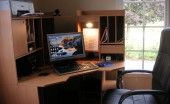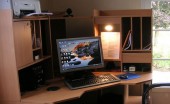The Importance of Well Designed Work Stations
Written by SayBuild Administration // August 19, 2013 // Home Office // Comments Off on The Importance of Well Designed Work Stations

When bosses are on the lookout for new items of office furniture, there are a number of issues that they must take into account. For example, they may well have tight budgets that they cannot afford to exceed, meaning they must succeed in getting products that represent great value for money. Also, they will no doubt want the items to look the part. Attractive office furniture can boost the appearance of working areas, which is important if firms are to make a good impression on visitors.
However, there is another and arguably more important issue for managers to consider and that is employee comfort and wellbeing. Without well-designed workstations, individuals can suffer a range of problems that have a negative impact on their health and wellbeing, as well as their ability to function effectively. Companies that ignore this issue are much more likely to find themselves subject to furniture at work complaints. They may also suffer as a result of reduced productivity, which is bad news for their bottom lines.
One man who knows all about the importance of effective furniture at work is Reid Railton. The Guardian writer noted that the introduction of mobile devices like laptops and tablets has caused problems for many people. He stated: “A lot of effort went into the ergonomics of using desktop PCs and workstations when they came into widespread use in the 1970s and 80s.” However, the same cannot be said for laptops and tablets.
Offering advice, he suggested that a workstation is not simply a PC or terminal, it is the whole working environment. The writer added: “A full workstation evaluation should include the desk and chair, any footrests and copyholders, cables, lighting, eye tests, work breaks, and training. The Guardian, for example, installed recessed ceiling lights in our Farringdon Road offices so there was no glare on screens, and raised the floors to run cables underneath. Some of us switched to headsets instead of phones (propping a phone in the crook of your neck is a really bad idea), and also bought subsidised ‘computer glasses’. These focus on screen distance (an arm’s length) without compromising for close-up or distance work.”
In general, workers’ eyes should be roughly level with the top of their computer screens and their arms should be horizontal to their keyboards, he pointed out. Also, people’s feet should be on the floor with their hips slightly above their knees.
Bosses may want to bear this in mind when they are conducting furniture at work reviews. When it comes to laptops and tablets, people can benefit from using risers to lift their screens and from plugging in separate keyboards, Mr Railton suggested. In other words, they should treat the items as they would a desktop.
However, many individuals do not follow such tips. Commenting on this, the writer said: “In my observation, most laptop workers use them on flat desks for extended periods – even multi-billionaires do it – and this may well result in neck problems.”
By taking a measured approach to office furniture and equipment, and by conducting effective workstation assessments, managers can avoid furniture at work problems.








 If you want to contribute tutorials, news or other money-related stuff:
If you want to contribute tutorials, news or other money-related stuff:  Share our home building library with your facebook friends:
Share our home building library with your facebook friends:  Do you have any ideas or suggestions you would like to make?
Do you have any ideas or suggestions you would like to make?  If you like what we do, please subscribe to our
If you like what we do, please subscribe to our  All content Copyright © 2012 SayBuild. Part of nBuy Home Management Network.
All content Copyright © 2012 SayBuild. Part of nBuy Home Management Network.